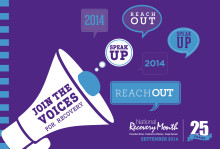 This month marks the 25th year of what has evolved into National Recovery Month. With an early focus on the slogan “Treatment Works,” the event took on its recovery focus in 1998 just as new and renewed grassroots recovery community organizations (RCOs) were rising across the U.S.
This month marks the 25th year of what has evolved into National Recovery Month. With an early focus on the slogan “Treatment Works,” the event took on its recovery focus in 1998 just as new and renewed grassroots recovery community organizations (RCOs) were rising across the U.S.
RCO representatives came together at the 2001 Recovery Summit in St Paul, MN to launch the formal organization of a new recovery advocacy movement under the leadership of Faces and Voices of Recovery.
In the intervening years, Recovery Month celebration events have grown beyond what anyone could have predicted. Local recovery celebration events that once welcomed a few dozen brave participants grew into the hundreds and then into the thousands.
This month, in community after community, recovering people and their families and allies will fill parks and streets as far as the eyes can see – an ocean of lives touched and transformed by recovery. More than 450 recovery celebration events are scheduled this month in the U.S. and such events will also transpire around the world – from Vancouver to Cape Town, from Tokyo to London.











